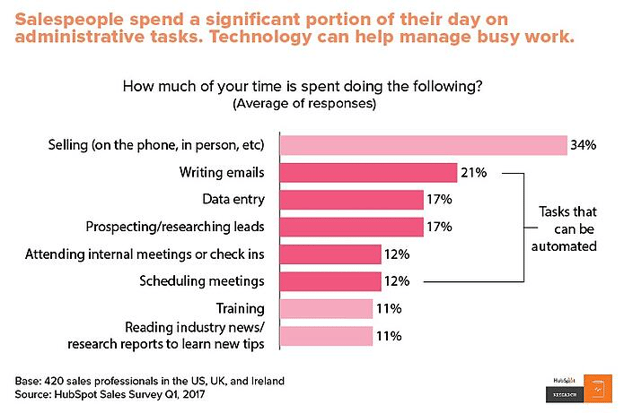When it comes to automation tools, marketing automation often gets all the glory. But a growing category of tools, sales automation, is picking up steam as remote and digital sales strategies become more mainstream. Truth be told, marketing and sales automation working together is a one-two punch. A strong sales and marketing alignment from strategy through technology can be a game-changer for revenue teams. So what’s the deal with sales automation? What is it, and how should an organization approach it when looking at their total sales and marketing technology investment? We’ll explore all of that and more in this Lake One guide.
What is Sales Automation?
Sales automation is the use of tools and technology to scale and automate manual elements of an organization’s sales process. Tasks include data management, follow up automation, call transcribing, and reporting. Sales automation seeks to eliminate manual tasks that often take up valuable time daily, weekly, and monthly. Sales teams can better utilize their time focused on higher-value sales activity like proposals and closing discussions.
Benefits of Sales Automation
While there are a host of benefits to automating elements of your sales McKinsey states that early adopters of sales automation report efficiency improvements of 10 -15%. Whether utilizing prepared proposals, AI to determine a contact’s likelihood of conversion, or chatbots – sales automation can make sure more time is focused on the highest value efforts.

Reduce pipeline friction
Using tools to automate functions within your salesforce has shown to lead to a 30% increase in deal closures and a reduction in the sales cycle by 18%, according to Instapage. Imagine how much more revenue you’d have flowing through your pipeline with those reductions in friction.
Improved morale
At the end of the day, if performance lags, so does morale, thus creating a vicious cycle. Morale drops, dragging down motivation and then impacting performance, and the cycle continues. With sales automation, it’s like giving your sales team an unfair advantage.
Essential Sales Activities to Automate
When approaching sales automation, the easiest place to start is thinking about your sales team’s major time drainers. A 2017 HubSpot sales survey of sales professionals in the US, UK and Ireland found that the typical sales day is wildly inefficient. In fact, salespeople spend less than half their day actually selling.

Emails, data management, prospecting, and more are all tasks that have either a portion of which or the entire task that can be automated. Looking at the tasks that the HubSpot survey identified, where can sales automation assist?
Email: Utilize templates and a canned response for common messages. It’s half the time just thinking about what you want to send, even if it’s a common message. A template can get you started and let you tailor a portion to your latest conversation with your prospect.
Data Entry: There are various browser plugins, email extensions and CRM add ons that help complete a contact profile with publicly available information. Whether it’s logging an email and creating a net new contact in a CRM from Google or outlook or adding someone from LinkedIn.
Prospecting: Effective prospecting for a modern salesperson is a balance between the numbers game and outreach quality to increase response rates. Areas to focus automation on include the qualifiers on building prospect lists and driving them into your CRM, sequences, and cadences used to conduct the outreach, calling tools to be able to call through a list with a direct dial and reduce time fumbling around with a phone.
Internal Meetings: When it comes to internal meetings and updates. Does everything need to be a meeting, or do you need better reporting and check-ins? Can communications be managed through a tool like slack with a status update through an app?
Scheduling: Trying to book a meeting with a prospect can be a nightmare. If you’re selling a complex product to a large group of influencers and people who need to sign off, now you’re managing multiple calendars. Automating the booking and availability eliminates all of the back and forth.
Tools for Sales Automation
So what tools help with these kinds of task automations for sales teams? I’m glad you asked.
Let’s explore some of the options available to support automating the essential tasks we’ve outlined in the previous section. In each section, we’ll provide a couple of options. First we’ll explore how HubSpot can solve the sales automation as a platform solution, a tool that can support multiple sales automation needs and work across other areas of your customer experience like marketing and customer experience.
Second, we’ll provide options for point solutions that can also integrate into other systems so you can plug and play depending on how your sales and marketing tech stack is architected today.
Email: HubSpot provides easy to deploy email templates that can be utilized across Outlook and Google mail. Templates through HubSpot also have the added benefit of reporting on performance so your sales organization can see which templates drive the best response and can be plugged into process across your organization.
If you’re looking for a plug and play solution, Right Inbox is an option if your business runs on Google Work, if you run on Office 365, AppSource has a variety of options as well.
Data Entry:HubSpot makes it easy to automatically log contacts from your inbox. They will also populate company records with publicly available data.
Depending on your CRM, both the Google Chrome Store and Office 365 AppSource are places to look for integrations to support data entry.
Prospecting: HubSpot Sequences make it easy to enroll up to 50 prospects at a time (depending on the tier you’re on) for a sales play. Email outreach, LinkedIn inmail, call, etc. With HubSpot calling, you can assign the call to a task queue and work through calls in a quick efficient way.
For plug and play options, there’s a host of sales cadence tools including Outreach, Salesloft, and Mailshake. All of which have robust integrations with a variety of CRMs and MAPs.
Internal Meetings: HubSpot reporting can go a long way to eliminate some needs for constant meetings and updates. The ability to tag and mention colleagues in real-time on contacts, companies, and deals also allows for communication and updates without leaving the CRM.
For plug and play, consider Slack plus Status Hero as a way to communicate regular updates without disrupting daily workflow.
Scheduling: HubSpot’s built-in meetings link allows you to connect to your Google or Outlook calendar and create custom booking availabilities. The link can be embedded in templates, sequences, or dropped into ad hoc emails to eliminate back and forth scheduling.
On the plug-and-play side, there are a host of booking solutions but the one we come across the most often and seems to have the most flexibility is Calendly.
When Should You Invest in Sales Automation?
There are several things to consider when looking at timing your sales automation investment. Vablet, a mobile sales enablement platform, points out 10 critical things to consider before investing in a sales enablement solution, for example, your sales tools are going to only be as good as the people using them. Invest in good people, then empower them with tools.
Additionally, just like in marketing, sales technology is not a replacement for a bad or missing process or strategy. If you haven’t developed a sales process and strategy that yields results – investing in sales tools isn’t going to help.


